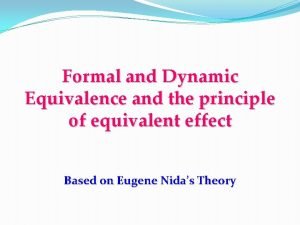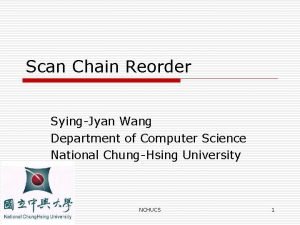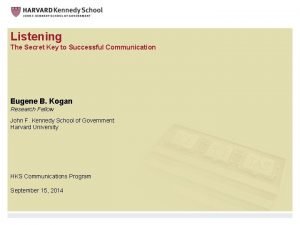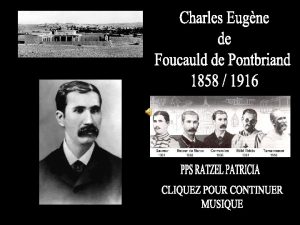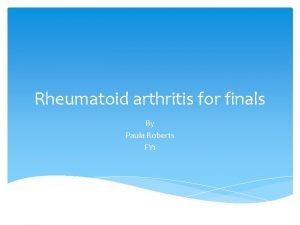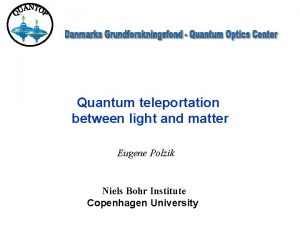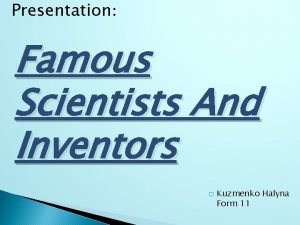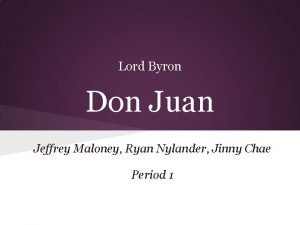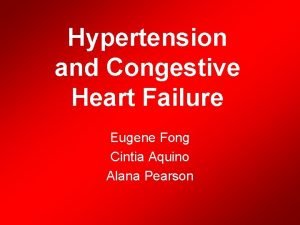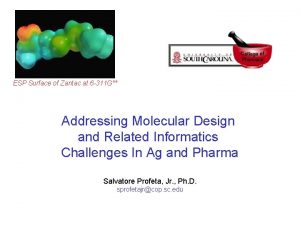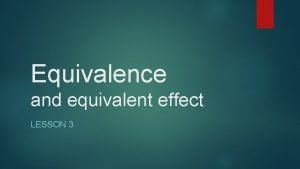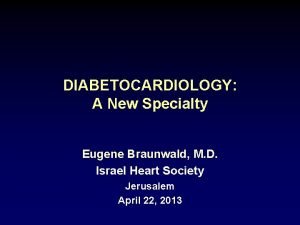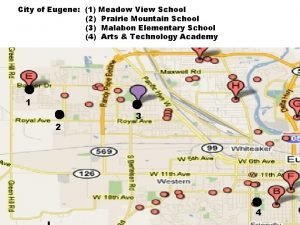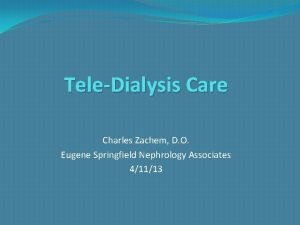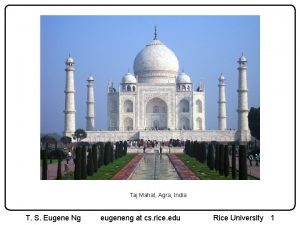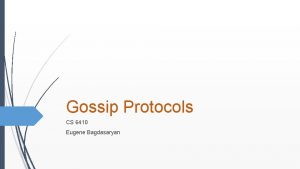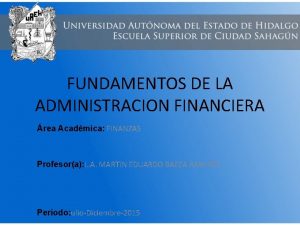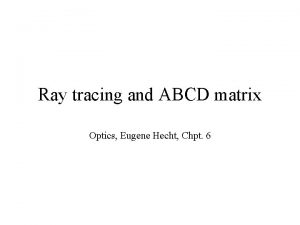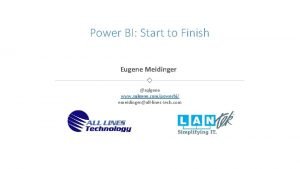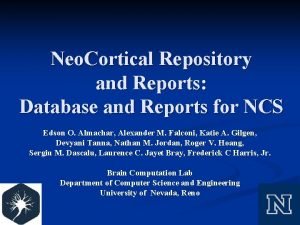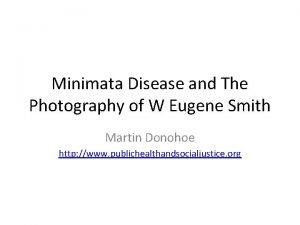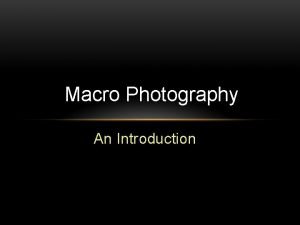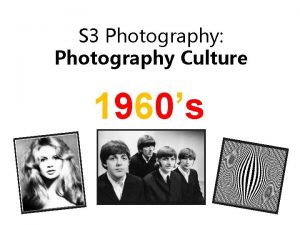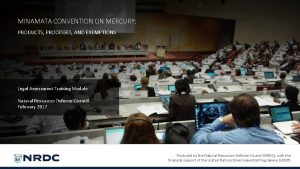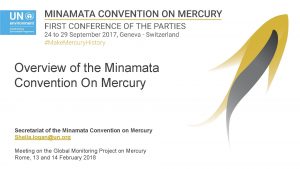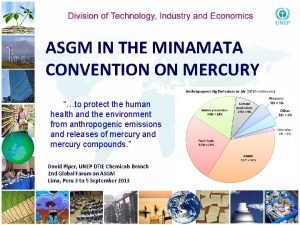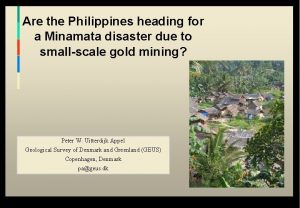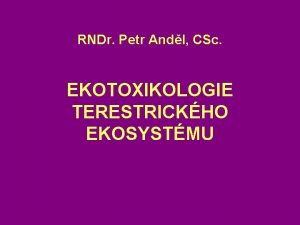Minamata Disease and The Photography of W Eugene


















































































- Slides: 82

Minamata Disease and The Photography of W Eugene Smith Martin Donohoe http: //www. publichealthandsocialjustice. org

Outline • Introduction • Mercury and Methylmercury as pollutants • Minamata Disease • W Eugene Smith – bio and photos • Minamata Convention

Mercury • Mercury ore (cinnabar) used as pigment since Neolithic era (found in 10, 000 yr old cave paintings) • Ancient Romans, Chinese used as rouge makeup • Pigment mixed with wax for document seals in Middle Ages

Mercury • Syphilis Treatment - 15 th Century onward - abandoned 1940 for penicillin • Recognized as cause of disease in 19 th Century (Hunter-Russell Syndrome) - chemists, hatters (matted fur together with mercuric nitrate to make felt hats)

Mercury • Used in late-19 th Century to extract silver from pulverized ore • Diuretic (used through mid-20 th Century) • Used as a preservative in latex paints until banned by EPA in 1991

Mercury • Added by US government to industrial alcohol during Prohibition to make it more lethal and discourage moonshine production (1926 -1933) – Led to more than 10, 000 deaths

Mercury • Used in chlor-alkali plants to make chlorine and sodium hydroxide for industry • Used in production of vinyl chloride, an important ingredient in plastics and vinyl

Mercury • Hg miners at high risk • Found today in Chinese medications, skin lightening creams, hair dyes

Mercury • Half from volcanic eruptions and other geological processes • Released into air by coal combustion, industrial processes, mining, and waste disposal – 4500 tons/yr

Mercury • Travels throughout atmosphere and settles in oceans and waterways • Bacteria convert it to toxic methyl-mercury • Levels in Great Lakes, Great Salt Lake rising

Mercury • Travels up food chain via fish – Warmer temperatures increase metabolic rate and ability of fish to accumulate – Avoid top predators (tuna, shark, swordfish • Acadian redfish, aka dogfish – used in school lunch programs – 1/3 of US exposure to methylmercury from canned tuna

Gold Mining Gold = Cyanide + Mercury • Mercury used to capture gold particles as an amalgam • Gold leached from ore using cyanide – Cyanide paralyzes cellular respiration • At least 18 tons of mine waste created to obtain the gold for a single 3 oz. , 18 k ring

Gold Mining and Mercury • Contaminated groundwater often sits in large toxic lakes held in place by tenuous dams • Release of cyanide and mercury into local waterways kills fish, harms fish-eating animals, and poisons drinking water

Mercury • Other sources: – Deforestation and runoff – Industrial boilers – Tooth fillings – Car batteries – Cosmetics

Mercury • Contaminant in high fructose corn syrup • Gluten-free diets may contain more mercury (and arsenic) due to higher intake of rice-/rice syrup-based products (rice absorbs metals from water and soil)

Mercury • Dental amalgams: – 50% mercury; 50% silver, copper, tin, zinc mixture – dental amalgam factory workers at high risk – Mercury dental amalgams pose health risks to pregnant women, unborn babies, and children (FDA Black Box Warning added 2009) – esp tooth grinders

Mercury • Dental amalgams: – No link with nervous system toxicity and no benefit to removal in adults – However, human cremations (increasing) releases 2 -4 g Hg/body if amalgams present

Mercury • 720, 000 metric tons removed from ground since 1850 • 57% of mercury released since 1850 circulates in environment • 43% locked away in sediments and landfills

Mercury • Long biological half-life - 1 -3 years in humans • Mercury costs U. S. economy $5 billion/yr • Regulation inadequate – Allows “cap and trade”

Mercury • 16% of women of childbearing age exceed the EPA’s “safe” mercury level • 75, 000 newborns/yr in US have increased risk of learning disabilities associated with mercury exposure in the womb • Freshwater fish mercury levels too high for pregnant women to eat in 43 states • Consumers Union disagrees with FDA recommended limits on tuna consumption for pregnant women – States pregnant women should not eat ANY tuna

Minamata Bay • • Southern Japan Shiranui Sea Fishing village Villagers: fisherman/Chisso Corporation employees and their families



Chisso Corporation • Established 1918 • Produced acetaldehyde for plastics, drugs, perfumes, photography • Mercury (Hg) catalyst • Byproduct = methylmercury, dumped into bay (150 tons over 4 decades) • Dumped over 60 deadly poisons, including vinyl chloride (cause of liver cancer)


Chronology of Chisso's Environmental Pollution • 1925 - local fishing cooperative compensated for decreased catch • 1950 s - bizarre behavioral changes observed in birds, marine fish, land vertebrates; oysters vanish • 1950 s / 1960 s - reports in Japanese medical journals about human cases

Chronology of Chisso's Environmental Pollution • 1956 - cause (Me. Hg) of Minamata Disease elucidated • 1958 -60 - reports in English medical journals • 1959 -69 - Dr. Hosokawa's experiments – Cat #400 – Other studies • 1959 cyclator added – Removed Hg, but not Me. Hg


Chronology of Chisso's Environmental Pollution • 1965 - fishing banned in Minamata Bay after similar events noted in Niigata, Japan • 1968 - all acetaldehyde-producing plants ceased operating • 1970 - Japan Water Pollution Control Act – Allowed no detectable Hg or Me. Hg in waste water

Chronology of Chisso's Environmental Pollution • 1997 – Minamata Bay declared free of mercury • 2004 – Japanese Supreme Court rules government shares responsibility for epidemic (government slow to react, cut off research funding in 1962)

Minamata Disease • 3, 000 official cases in Minamata Bay (almost 2, 500 dead) – Tens of thousands of unofficial cases – Number of victims may be as high as 100, 000 • Social stigma / Poor health care

Congenital Minamata Disease: Signs and Symptoms • Congenital: high dose → infertility; medium dose → spontaneous abortions; low dose → congenital disease (including anencephaly and spina bifida) • S/S: poor physical growth, mental retardation, impaired speech/chewing/swallowing, muscle tone abnormalities, involuntary movements, constricted visual fields - EDTA not effective

Signs and Symptoms • Acute / Chronic Poisoning: – Numbness, slurred speech, ataxia, unsteady gait, deafness, poor vision, dysphagia, hypersalivation, confusion, drowsiness/stupor to irritability/restlessness – Linked to autism – Chronic liver disease, liver cancer – Nephropathy

Signs and Symptoms • Acute / Chronic Poisoning: – Hypertension – Autoimmune disorders – Rash - Acrodynia (“pink disease”, small children, swelling and irritation of palms and feet → desquamation, irritability, photophobia, fever, insomnia, profuse sweating – Death within a few months if severe

Diagnosis • Mercury levels in air, blood, urine: – “Normal” level = 5 mcg/l – 20 mcg/l – 100 mcg/l = subacute toxicity, consider treatment – >100 mcg/l in blood and/or urine = toxic, treat

Treatment • Chelation with BAL, penicillamine, DMPS, DMSA (best) – May help with neurologic symptoms – Nephrotic syndrome resolves over several months – Follow levels to assess adequacy of treatment, need for additional doses – Consult occupational medicine/poison control





Civil suit vs. Chisso (1969 -73) • Plaintiffs initially awarded $66, 000 for deceased victims, $59, 000 - $66, 000 for survivors • Precedent - Niigata suit versus Showa Denko – $3. 4 million paid out the first night, $80 million paid out by 1975 • As of 2014, most victims have received financial compensation ($160, 000 - $180, 000; $26000 for those with lesser disabilities)



Civil suit vs. Chisso (1969 -73) • Dr. Hosokawa key witness (from deathbed) – Identity - company employee vs. impartial physician with obligation to patients – Loyalty - company vs. to public


Reasons for Delayed Recognition and Action • Science slow, unfunded/underfunded, corrupt • Dissemination of knowledge slow • Social stigma of disease, fear of contagion • Pressure from fisheries cooperative, Chisso employees

Reasons for Delayed Recognition and Action • Lack of local/world awareness of health effects of pollution • Strong government-business links in Japan, employee loyalty strong

Decreasing Causes and Limiting Consequences of Mercury Pollution • Phase out coal burning power plants • Hospitals phasing out mercury thermometers • Stop buying gold (e. g. , wedding rings) • Make healthy seafood purchases • Screen and treat when appropriate • Avoid tainted cosmetics

Minamata Convention • A set of legally binding measures to curb mercury pollution – As of October, 2017, 128 countries have signed and 6 (including the U. S. ) have ratified – Took effect August, 2017

Minamata Convention • A set of legally binding measures to curb mercury pollution – As of 10/16/14, 128 countries have signed and 6 (including the U. S. ) have ratified – Takes effect 90 days after 50 nations ratify

Minamata Convention • Best emission-control technologies requred for new power plants, boilers and smelters • Compact fluorescent lightbulbs containing over 5 mg Hg banned by 2020 • Primary mercury mining banned (old mines get 15 yrs to close down) • Allows use of mercury in artisanal and small scale gold mining; encourages nations to phase out use altogether

Minamata Convention • Exempts dental fillings, but encourages alternatives • Vaccines with thimerosol (ethylmercury) exempt (very few, trace amounts) • Considered “safe” but best to avoid if possible • But benefits of vaccination great

Minamata Convention • Bans Hg-containing batteries by 2020 (button-cell batteries exempt) • Bans switches and relays with Hg by 2020 • Limits Hg in soaps and some cosmetics

Minamata Convention • Bans Hg in medical devices by 2020 • Exempts religious and traditional uses of Hg • Bans use in certain types of manufacturing • Japan – Asia’s largest exporter of mercury • Japanese industry fighting treaty/trade ban

Minamata Disease Memorial

W Eugene Smith • Born 1918, Wichita, KS • Local news photographer at age 15 • Turned down scholarship to Notre Dame to study photography at NY Institute of Photography • Worked for Newsweek, then Life, then Magnum

W Eugene Smith • • Married to Aileen Smith, photojournalist Minamata: Final Assignment Beaten by Chisso employees Died 1978















Role of the Media in Promoting Awareness of Environmental Health Issues • Books – Henrik Ibsen’s Enemy of the People – Upton Sinclair's The Jungle – Rachel Carson's Silent Spring • Photography – W. Eugene and Aileen Smith's Minamata photoessay – Jacob Riis, Dorothea Lange, Sebastiao Salgado, James Nachtwey, others • Film, TV










Contact Info, References Martin Donohoe martindonohoe@phsj. org This slide show and others available at http: //www. publichealthandsocialjustice. org http: //www. phsj. org
 Is abstract photography same as conceptual photography
Is abstract photography same as conceptual photography Communicable disease and non communicable disease
Communicable disease and non communicable disease Formal equivalence meaning
Formal equivalence meaning Hình ảnh bộ gõ cơ thể búng tay
Hình ảnh bộ gõ cơ thể búng tay Ng-html
Ng-html Bổ thể
Bổ thể Tỉ lệ cơ thể trẻ em
Tỉ lệ cơ thể trẻ em Chó sói
Chó sói Tư thế worms-breton
Tư thế worms-breton Chúa sống lại
Chúa sống lại Kể tên các môn thể thao
Kể tên các môn thể thao Thế nào là hệ số cao nhất
Thế nào là hệ số cao nhất Các châu lục và đại dương trên thế giới
Các châu lục và đại dương trên thế giới Công thức tính thế năng
Công thức tính thế năng Trời xanh đây là của chúng ta thể thơ
Trời xanh đây là của chúng ta thể thơ Mật thư tọa độ 5x5
Mật thư tọa độ 5x5 Làm thế nào để 102-1=99
Làm thế nào để 102-1=99 độ dài liên kết
độ dài liên kết Các châu lục và đại dương trên thế giới
Các châu lục và đại dương trên thế giới Thể thơ truyền thống
Thể thơ truyền thống Quá trình desamine hóa có thể tạo ra
Quá trình desamine hóa có thể tạo ra Một số thể thơ truyền thống
Một số thể thơ truyền thống Cái miệng bé xinh thế chỉ nói điều hay thôi
Cái miệng bé xinh thế chỉ nói điều hay thôi Vẽ hình chiếu vuông góc của vật thể sau
Vẽ hình chiếu vuông góc của vật thể sau Thế nào là sự mỏi cơ
Thế nào là sự mỏi cơ đặc điểm cơ thể của người tối cổ
đặc điểm cơ thể của người tối cổ Thế nào là giọng cùng tên? *
Thế nào là giọng cùng tên? * Vẽ hình chiếu đứng bằng cạnh của vật thể
Vẽ hình chiếu đứng bằng cạnh của vật thể Phối cảnh
Phối cảnh Thẻ vin
Thẻ vin đại từ thay thế
đại từ thay thế điện thế nghỉ
điện thế nghỉ Tư thế ngồi viết
Tư thế ngồi viết Diễn thế sinh thái là
Diễn thế sinh thái là Dạng đột biến một nhiễm là
Dạng đột biến một nhiễm là Các số nguyên tố
Các số nguyên tố Tư thế ngồi viết
Tư thế ngồi viết Lời thề hippocrates
Lời thề hippocrates Thiếu nhi thế giới liên hoan
Thiếu nhi thế giới liên hoan ưu thế lai là gì
ưu thế lai là gì Hổ sinh sản vào mùa nào
Hổ sinh sản vào mùa nào Sự nuôi và dạy con của hổ
Sự nuôi và dạy con của hổ Sơ đồ cơ thể người
Sơ đồ cơ thể người Từ ngữ thể hiện lòng nhân hậu
Từ ngữ thể hiện lòng nhân hậu Thế nào là mạng điện lắp đặt kiểu nổi
Thế nào là mạng điện lắp đặt kiểu nổi Eugene jyan
Eugene jyan Eugene b kogan
Eugene b kogan Kaiser permanente pharmacy eugene
Kaiser permanente pharmacy eugene Guilford county schools eugene street
Guilford county schools eugene street Eugene talmadge definition
Eugene talmadge definition Eugene stoner
Eugene stoner Eugene marconi
Eugene marconi Charles eugène de foucauld de pontbriand
Charles eugène de foucauld de pontbriand Dr eugene lim rheumatologist
Dr eugene lim rheumatologist Eugene polzik
Eugene polzik Eugene paton was born in 1870
Eugene paton was born in 1870 Eugene mcdarby pip
Eugene mcdarby pip Ryan nylander
Ryan nylander Eugene fornecker
Eugene fornecker Eugene fornecker
Eugene fornecker Eugene fong
Eugene fong Eugene logusch
Eugene logusch Formal equivalence vs. dynamic equivalence ni eugene nida
Formal equivalence vs. dynamic equivalence ni eugene nida Eugene braunwald
Eugene braunwald Meadowview school eugene
Meadowview school eugene Eugene springfield nephrology associates
Eugene springfield nephrology associates T. s. eugene ng
T. s. eugene ng Eugene atget
Eugene atget Eugene qeather
Eugene qeather Pof bandwidth
Pof bandwidth Eugene bagdasaryan
Eugene bagdasaryan Finanzas corporativas eugene f. brighman
Finanzas corporativas eugene f. brighman Oyunlarm
Oyunlarm Eugene stearns
Eugene stearns Ted lai md
Ted lai md Charles eugene williams
Charles eugene williams Teatro del absurdo
Teatro del absurdo Eugene ionesco teatro del absurdo
Eugene ionesco teatro del absurdo Abcd matrix example
Abcd matrix example Eugene meidinger
Eugene meidinger Eugene richards the fat baby
Eugene richards the fat baby Eugene m. izhikevich
Eugene m. izhikevich Massacre at chios eugene delacroix
Massacre at chios eugene delacroix


